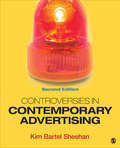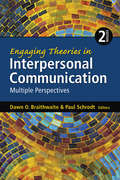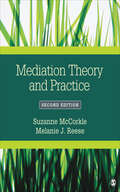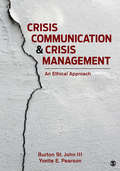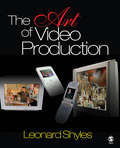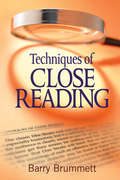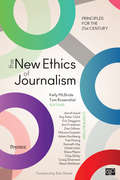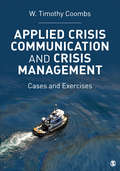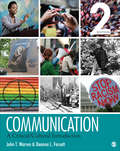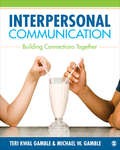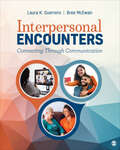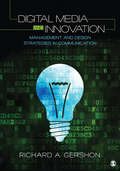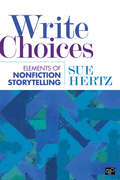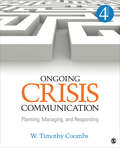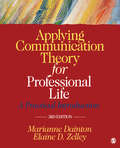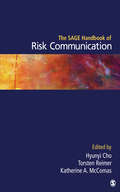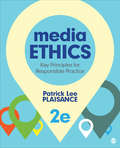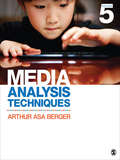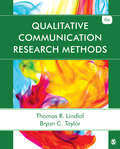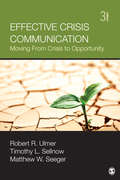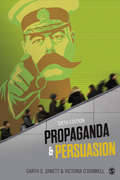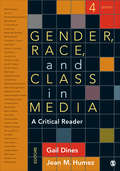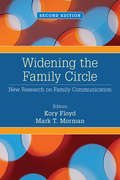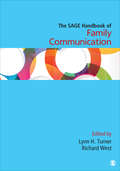- Table View
- List View
Controversies in Contemporary Advertising
by Kim B. SheehanPresenting a range of perspectives on advertising in a global society, this Second Edition of Controversies in Contemporary Advertising, by Kim Bartel Sheehan, examines economic, political, social, and ethical perspectives and covers a number of topics including stereotyping, controversial products, consumer culture, and new technology. The book is divided equally between macro and micro issues, providing a balanced portrait of the role advertising has in society today. Author Kim Bartel Sheehan's work recognizes the plurality of opinions towards advertising, allowing the reader to form and analyze their own judgments. It encourages readers to obtain a critical perspective on advertising issues.
Engaging Theories in Interpersonal Communication: Multiple Perspectives
by Dr Dawn O. Braithwaite Dr Paul SchrodtUse and Understand Interpersonal Communication Theories Engaging Theories in Interpersonal Communication: Multiple Perspectives highlights key theories used to guide interpersonal communication research. The Second Edition features 30 theory chapters written by leading scholars in interpersonal communication, including new coverage of evolutionary theories, Problematic Integration Theory, supportive communication theories, Theory of Motivated Information Management, critical approaches to interpersonal communication, and Media Multiplexity Theory. Each theory chapter follows the same structure to help readers easily find and compare information across theories. An updated introductory chapter maps the history and the current state of interpersonal communication theory since publication of the first edition, based on comprehensive analysis of published scholarship. Presenting both classic and cutting-edge issues, the book organizes theories into three clusters—theories that are individually-centered; theories that are focused on discourse and interaction processes; and theories that examine how communication functions in personal relationships. All authors interweave abstract theoretical concepts with concrete examples in order to maximize readability and comprehension.
Mediation Theory and Practice
by Suzanne Mccorkle Melanie J. ReeseBlending theory and research with practical application, Mediation Theory and Practice, Second Edition, by Suzanne McCorkle and Melanie J. Reese, provides a thorough introduction to today’s ever expanding world of mediation, including updated research and new cases for analysis. Innovative yet practical, research-based yet readable, the book provides an overview of the basic principles of mediation in a variety of contexts to help readers understand mediation and its role in today’s society. Throughout the book, the authors help readers develop foundational mediation skills, including issue identification, setting the agenda for negotiation, problem solving, settlement, and closure. Case studies and examples in every chapter, plus an appendix of role-playing scenarios, make this book ideal book for both college courses and certification training programs.
Crisis Communication and Crisis Management: An Ethical Approach
by Burton St. John Yvette E. PearsonEquip your students with a strong understanding of the essential role that communicators play in moments of crisis and the tools they need to conduct ethically sound crisis management.
The Art of Video Production
by Dr Leonard C. ShylesThe Art of Video Production emphasizes the enduring principles and essential skills of the communication process and the new digital technologies that are necessary to create effective video content. Author Leonard C. Shyles uses a unique approach by explaining how things are done and why things are done rather than just that they are done—it is not about concepts versus skills, but about concepts and skills.
Techniques of Close Reading
by Barry S. BrummettIn a world in which messages increasingly ask us to believe, accept, buy, and follow, the ability to read texts closely in order to gain a deeper understanding of their meanings is an indispensable survival skill. Techniques of Close Reading is a brief book that helps students see what texts may be saying, be they written, oral, visual, or mediated. Renowned scholar and professor Barry Brummett explains and explores the various ways to "read" messages (such as speeches, cartoons, or magazine ads), teaching students how to see deeper levels of meaning and to share those insights with others. Students learn techniques for discovering form, rhetorical tropes, argument, and ideologies within texts.This book differs from other books in rhetorical criticism, textual analysis, or critical thinking by: Focusing on the act and techniques of criticism rather than on schools of thought, grand theories, and specific methods, thus helping students to engage in the act of critical close reading in ways that are congenial to a wide range of methods - making the book an ideal companion to texts focused on specific methodsExplaining the relationships among theory, methods, and techniques of rhetorical criticismExamining the ethics and risks of doing and reading rhetorical criticism via plenty of examples, figures, and exercises taken from everyday life Serving as a brief, affordable text, thus allowing instructors the flexibility to assign other textbooks
The New Ethics of Journalism: Principles for the 21st Century
by Kelly McBride Tom RosenstielFeaturing a new code of ethics for journalists and essays by 14 journalism thought leaders and practitioners, this authoritative, practical book examines the new pressures brought to bear on journalism by technology and changing audience habits. It offers a new framework for making critical moral choices, as well as case studies that reinforce the concepts and principles rising to prominence in 21st century communication. The book addresses the unique problems facing journalism today, including how we arrive at truth in an era of abundant and unverified information; the evolution of new business models and partnerships; the presence of journalists on independent social media platforms; the role of diversity; the meaning of stories; the value of images; and the role of community in the production of journalism.
Applied Crisis Communication and Crisis Management: Cases and Exercises
by Timothy CoombsDesigned to give students and public relations professionals the knowledge and skills they need to become successful crisis managers, Applied Crisis Communication and Crisis Management: Cases and Exercises by W. Timothy Coombs, includes a wide range of cases that explore crisis communication and management in action using a practical approach. In the first two chapters, the author introduces key theories and principles in crisis communication, which students apply by analyzing 17 cases drawn from recent headlines. Cases are explored from pre-crisis, mid-crisis, and post-crisis communication perspectives, and include a range of predominant crisis scenarios from product recalls to lawsuits to environmental disasters.
Communication: A Critical/Cultural Introduction
by Dr John T. Warren Dr Deanna L. FassettCommunication: A Critical/Cultural Introduction, Second Edition introduces communication, from intimate and interpersonal to the public and mediated, as cultural. Using contemporary critical theory, authors John T. Warren and Deanna L. Fassett focus on communication as advocacy—inherently influenced by culture, history and power. By situating communication concepts and theories within contemporary and engaging cultural scenes, the book is much more than a survey of ideas—it demonstrates the power of communication in our everyday lives.
Business and Professional Communication: KEYS for Workplace Excellence
by Dr Kelly M. Quintanilla Dr Shawn T. WahlPresenting an exciting new approach to teaching the core concepts and techniques of business and professional communication, Business and Professional Communication: KEYS for Workplace Excellence, Second Edition by Kelly M. Quintanilla and Shawn T. Wahl is organized in a way that best reflects the way that students transition from their student environment to their professional careers. Indeed, the fully updated second edition of this best-seller continues to focus on helping readers master the skills they need to move from interviewee to team member to leader, and provides unique coverage of some of the greatest challenges of today's workplace, such as the negative impacts of technology and achieving work-life balance. Incorporating coverage of the latest cultural, economic, and technological developments in the business world, the authors cover communication must-know concepts and skills through the application of their Four Keys Process: Know yourself, Evaluate the professional context, Your communication interaction occurs, and Step back and reflect.
Interpersonal Communication: Building Connections Together
by Teri Kwal Gamble Michael W. GambleWritten in a conversational style for students living in today's world of ever-evolving media and new technology, this hands-on skills guide by Teri Kwal Gamble and Michael W. Gamble puts students at the center of interpersonal communication. To help them become better, more successful communicators, married author team Teri Kwal Gamble and Michael Gamble shed new light on the dynamics of students' everyday interactions and relationships, and give students the tools they need to develop and cultivate effective communication skills. Using an applied, case-study approach that draws from popular culture and students' own experiences, Gamble and Gamble go beyond skill building by encouraging readers to critically reflect on their own communication patterns and actively apply relevant theory to develop and maintain healthy relationships with family, friends, romantic partners, and co-workers. Designed to promote self-reflection and develop students' interpersonal communication skills, each chapter of this engaging text examines how media, technology, gender, and culture affect the dynamics of relationships and self-expression.
Interpersonal Encounters: Connecting Through Communication
by Laura K. Guerrero Bree McEwanWith a practical and innovative approach, Interpersonal Encounters: Connecting through Communication shows students how interpersonal communication skills can be best used to accomplish everyday relationship goals. Guided by current interpersonal research from diverse authors and study participants, Laura K. Guerrero and Bree McEwan focus on the functions of interpersonal communication in our everyday lives and demonstrate how concepts, theories, and contemporary research apply to building, maintaining, and ending relationships. The book’s unique structure prepares students to become better communicators in their personal and professional lives. This title is accompanied by a complete teaching and learning package. Contact your SAGE representative to request a demo. Digital Option / Courseware SAGE Vantage is an intuitive digital platform that delivers this text’s content and course materials in a learning experience that offers auto-graded assignments and interactive multimedia tools, all carefully designed to ignite student engagement and drive critical thinking. Built with you and your students in mind, it offers simple course set-up and enables students to better prepare for class. Learn more. Assignable Video with Assessment Assignable video (available with SAGE Vantage) is tied to learning objectives and curated exclusively for this text to bring concepts to life. Watch a sample video now. LMS Cartridge: Import this title’s instructor resources into your school’s learning management system (LMS) and save time. Don’t use an LMS? You can still access all of the same online resources for this title via the password-protected Instructor Resource Site. Learn more.
Digital Media and Innovation: Management and Design Strategies in Communication
by Dr Richard A. GershonDigital Media and Innovation, by Richard A. Gershon, takes an in-depth look at how smart, creative companies have transformed the business of media and telecommunications by introducing unique and original products and services. Today's media managers are faced with the same basic question: what are the best methods for staying competitive over time? In one word: innovation. From electronic commerce (Amazon, Google) to music and video streaming (Apple, Pandora, and Netflix), digital media has transformed the business of retail selling and personal lifestyle. This text will introduce current and future media industry professionals to the people, companies, and strategies that have proven to be real game changers by offering the marketplace a unique value proposition for the consumer.
Write Choices: Elements of Nonfiction Storytelling
by Susan Sue HertzDeveloping nonfiction writers at any stage of their career Write Choices: Elements of Nonfiction Storytelling helps writers cultivate their nonfiction storytelling skills by exploring the universal decisions writers confront when crafting any kind of factual narrative. Rather than isolating various forms of narrative nonfiction into categories or genres, Sue Hertz focuses on examining the common choices all true storytellers encounter, whether they are writing memoir, literary journalism, personal essays, or travel essays. And since today’s writers are no longer confined to paper, Write Choices also includes digital storytelling options, and how writers can employ technology to enhance their narratives. Integrating not only her own insights and experience as a journalist, nonfiction book author, and writing instructor, but also those of other established nonfiction storytellers, both print and digital, Hertz aims to guide writers through key decisions to tell the best story possible. Blending how-to instruction with illuminating examples and commentaries drawn from original interviews with master storytellers, Write Choices is a valuable resource for all nonfiction writers, from essayists to memoirists to literary journalists, at any stage of their career.
Ongoing Crisis Communication: Planning, Managing, and Responding
by Timothy CoombsOngoing Crisis Communication: Planning, Managing, and Responding provides an integrated and multi-disciplinary approach to the entire crisis communication process. Drawing on his extensive firsthand experience, Dr. Timothy Coombs uses a three-staged approach to crisis management (pre-crisis, crisis, and post-crisis), explains how crisis management can prevent or reduce the threats of a crisis, and provides guidelines for how best to act and react in an emergency situation. The book includes new coverage of social media, social networking sites, and terrorist threats while drawing from recent works in management, public relations, organizational psychology, marketing, organizational communication, and computer-mediated communication research.
Applying Communication Theory for Professional Life: A Practical Introduction
by Marianne Dainton Elaine D. ZelleyThis fully updated Third Edition of Applying Communication Theory for Professional Life helps readers understand communication theory and its importance to careers in communication and business. Practical and reader-friendly, the book offers succinct coverage of the major theories that have clear applicability to communication and business practitioners, including theories of intrapersonal communication, interpersonal interaction, intercultural encounters, persuasion, group communication, organizational behavior, social media, and mass communication. In every chapter, authors Marianne Dainton and Elaine D. Zelley illustrate how theory is applied in a variety of professional settings through real-world case studies.
The SAGE Handbook of Risk Communication
by Hyunyi Cho Torsten Reimer Katherine A. MccomasIn this comprehensive, state-of-the-art overview of risk communication, the field’s leading experts summarize theory, current research, and practice in a range of disciplines and describe effective communication approaches for risk situations in diverse contexts, such as health, environment, science, technology, and crisis. Offering practical insights, the contributors consider risk communication in all contexts and applications—interpersonal, organizational, and societal—offering a wider view of risk communication than other volumes. Importantly, the handbook emphasizes the communication side of risk communication, providing integrative knowledge about the models, audiences, messages, and the media and channels necessary for effective risk communication that enables informed judgments and actions regarding risk. Editors Hyunyi Cho, Torsten Reimer, and Katherine McComas have significantly contributed to the field of risk communication with this important reference work—a must-have for students, scholars, and risk and crisis communication professionals.
Media Ethics: Key Principles for Responsible Practice
by Dr Patrick L. PlaisanceMedia Ethics: Key Principles for Responsible Practice makes ethics accessible and applicable to media practice, and explains key ethical principles and their application in print and broadcast journalism, public relations, advertising, marketing, and digital media. Unlike application-oriented casebooks, this text sets forth the philosophical underpinnings of key principles and explains how each should guide responsible media behavior. Author Patrick Lee Plaisance synthesizes classical and contemporary ethics in an accessible way to help students ask the right questions and develop their critical reasoning skills, as both media consumers and media professionals of the future. The Second Edition includes new examples and case studies, expanded coverage of digital media, and two new chapters that distinguish the three major frameworks of media ethics and explore the discipline across new media platforms, including blogs, new forms of digital journalism, and social networking sites.
Media Analysis Techniques
by Dr Berger Arthur AIn the Fifth Edition of Media Analysis Techniques, author Arthur Asa Berger provides students with a clearly written, user-friendly, and hands-on guide to media criticism. He empowers readers to make their own analyses of the media rather than just accepting the interpretations of others. The book first examines four techniques of media interpretation—semiotic theory, Marxist theory, psychoanalytic theory, and sociological theory—that Berger considers critical for creative people to acknowledge if they are to understand how their creations translate to the real world. Application chapters then link popular culture to these four theories. Written in an accessible style that demystifies complex concepts, the book also includes a comprehensive glossary, study guides, and the author’s own illustrations.
Qualitative Communication Research Methods (Fourth Edition)
by Thomas R. Lindlof Bryan C. TaylorQualitative Communication Research Methods, Fourth Edition introduces you to qualitative research in speech and mass communication. Award-winning scholars and authors Thomas R. Lindlof and Bryan C. Taylor guide you through every step of the qualitative process, from developing research topics and questions through writing a final report. You are given numerous examples of work in the field to illustrate how studies are designed, carried out, written, evaluated, and related to theory. In addition to covering the theories and methods currently used in qualitative communication research, the authors also discuss important trends influencing the future of that research, helping you make informed judgments about the significance and consequences of recent trends.
Effective Crisis Communication: Moving From Crisis to Opportunity
by Dr Robert R. Ulmer Dr Timothy L. Sellnow Matthew W. SeegerIn this fully updated Third Edition, three of today’s most respected crisis/risk communication scholars provide the latest theory, practice, and innovative approaches for handling crisis. This acclaimed book presents a clear understanding about how to manage risks and crises effectively. The authors provide 18 in-depth case studies that highlight successes and failures in dealing with core issues of crisis leadership, managing uncertainty, communicating effectively, understanding risk, promoting communication ethics, enabling organizational learning, and producing renewing responses to crisis. Unlike other crisis communication texts, this book answers the question, “What now?” and explains how organizations can and should emerge from crisis. Authors Robert R. Ulmer, Timothy L. Sellnow, and Matthew W. Seeger provide guidelines for taking the many challenges that crises present and turning those challenges into opportunities.
Propaganda & Persuasion
by Dr Garth S. Jowett Victoria J. O'DonnellPropaganda and Persuasion, Sixth Edition, by Garth S. Jowett and Victoria O’Donnell, is the only book of its kind to comprehensively cover the history of propaganda and offer insightful definitions and methods to analyze it. Fascinating examples, from ancient times to present day, facilitate a solid understanding of what propaganda is. The book includes current research in propaganda and persuasion, discusses the use of propaganda in psychological warfare, and offers students a systematic approach to analyzing the propaganda and persuasion they will encounter in everyday life.
Gender, Race, and Class in Media: A Critical Reader (Fourth Edition)
by Gail Dines Jean M. HumezThis provocative new edition of Gender, Race, and Class in Media engages students with a comprehensive introduction to mass media studies. <P><P>Editors Gail Dines and Jean M. Humez present new and classic readings that critically analyze some of the most pervasive and influential forms of media entertainment culture, including advertising, reality tv shows, sitcoms and dramatic series, pornography, fan and celebrity gossip websites, videogames and online social media and virtual reality enterprises. <P>Issues of power related to gender, race, class and sexuality are integrated into a wide range of compelling articles examining the economic and cultural implications of mass media as institutions, such as the political economy of media production, textual analysis, and media consumption, including current questions raised by fan participation in production and distribution.
Widening the Family Circle: New Research on Family Communication
by Dr Kory W. Floyd Dr Mark T. MormanWidening the Family Circle: New Research on Family Communication, Second Edition continues to address historically under-studied family relationships, such as those involving grandparents, in-laws, cousins, stepfamilies, and adoptive parents. In this engaging text, editors Kory Floyd and Mark T. Morman bring together a diverse collection of empirical studies, theoretic essays, and critical reviews of literature on communication to constitute a stronger, more complete understanding of communication within the family.
The SAGE Handbook of Family Communication
by Dr Lynn H Turner Richard L. WestA thorough exploration of the critical topics and issues facing family communication researchers today The Sage Handbook of Family Communication provides a comprehensive examination of family communication theory and research. Chapters by leading scholars in family communication expand the definition of family, address recent shifts in culture, and cover important new topics, including families in crisis, families and governmental policies, social media, and extended families. The combination of groundbreaking theories, research methods, and reviews of foundational and emerging research in family communication make this an invaluable resource that explores the critical topics and issues facing family communication researchers today.
